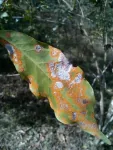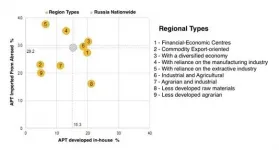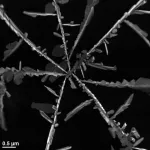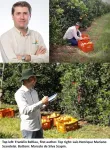New ink jet approach offers simple way to print microdisk lasers for biosensing
Advance could one day allow on-demand, on-site printing of biosensors
2021-02-03
(Press-News.org) WASHINGTON -- Researchers have developed a unique inkjet printing method for fabricating tiny biocompatible polymer microdisk lasers for biosensing applications. The approach enables production of both the laser and sensor in a room temperature, open-air environment, potentially enabling new uses of biosensing technologies for health monitoring and disease diagnostics.
"The ability to use an inexpensive and portable commercial inkjet printer to fabricate a sensor in an ambient environment could make it possible to produce biosensors on-site as needed," said research team leader Hiroaki Yoshioka from Kyushu University in Japan. "This could help make biosensing widespread even in economically disadvantaged countries and regions, where it could be used for simple biochemical tests, including those for pathogen detection."
In The Optical Society (OSA) journal Optical Materials Express, the researchers describe the ability to print microdisk lasers as small as the diameter of a human hair from a specially developed polymer called FC-V-50. They also show that the microdisks can successfully be used for biosensing with the widely used biotin-avidin system.
"Our technique can be used to print on almost any substrate," said Yoshioka. "This means that it could one day be possible to print a sensor for health monitoring directly on the surface of a person's fingernail, for example."
Eliminating the heat
Many of today's biosensors use the strong interaction between the molecules biotin and avidin to detect the presence of proteins that indicate infection or disease. This typically involves tagging a molecule of interest with biotin and then detecting when avidin binds to it.
One way to measure biotin-avidin binding is to add a biotin-labeled protein to the surface of an optical microcavity that acts like a miniature laser. When avidin binds to the biotin on the microcavity, its optical properties change enough to shift light emission in a way that can be used to detect binding.
However, the modification process needed to add biotin to the surface of microcavities is tedious and time-consuming. It also requires high-temperature heat treatments that aren't compatible with all materials, such as polymers.
"We developed an organic microdisk optical cavity laser for biosensing using FC-V-50," said Yoshioka. "This special inkjet polymer has a carboxyl functional group that is compatible with biotin, which eliminates the need for any type of heat treatment."
Printing sensors
To produce microdisk lasers, the researchers developed an ink that contained FC-V-50 and a laser dye. A piezo element embedded in an inkjet nozzle about the size of a hair allows a single, tiny ink droplet to be ejected when a voltage is applied. Once dry, this printed drop will emit light when excitation light is applied. As the light travels along the inside circumference of the disk it is amplified to generate laser light.
To turn the microdisk laser into a sensor, the researchers printed a microdisk using their inkjet method and then added reagents that allowed biotin to immobilize on its surface at room temperature. They then used light to excite the microdisk laser under a microscope and measured the reference laser emission spectrum. Next, they poured the avidin solution onto the surface of the microdisk and washed away any that didn't bind to the biotin. The laser emission was measured again to see how it deviated from the reference spectrum.
To test the method, the researchers fabricated biosensors and measured their ability to detect streptavidin protein at different concentrations. They were able to detect a maximum mode shift of 0.02 nanometers for a 0.1 parts per million concentration of streptavidin. Now that they have demonstrated the ability to print functioning biosensors, they plan to further evaluate and optimize sensor performance. Portable devices for measuring the light emission would also need to be developed for the sensors to be used at the point of care.
INFORMATION:
Paper: A. Nasir, Y. Mikami, R. Yatabe, H. Yoshioka, N. Vasa, Y. Oki, "Fully room temperature and label free biosensing based on ink-jet printed polymer microdisk laser," Opt. Mater. Express 11, 3, 592-602 (2021).
DOI: https://doi.org/10.1364/OME.415000.
Optical Materials Express
Optical Materials Express is an open-access journal focusing on the synthesis, processing and characterization of materials for applications in optics and photonics. It is published by The Optical Society (OSA) and emphasizes advances in novel optical materials, their properties, modeling, synthesis and fabrication techniques; how such materials contribute to novel optical behavior; and how they enable new or improved optical devices. The editor-in-chief is Alexandra Boltasseva from Purdue University, USA. Optical Materials Express is available online at OSA Publishing.
About The Optical Society
Founded in 1916, The Optical Society (OSA) is the leading professional organization for scientists, engineers, students and business leaders who fuel discoveries, shape real-life applications and accelerate achievements in the science of light. Through world-renowned publications, meetings and membership initiatives, OSA provides quality research, inspired interactions and dedicated resources for its extensive global network of optics and photonics experts. For more information, visit osa.org.
Media Contact:
mediarelations@osa.org
[Attachments] See images for this press release:
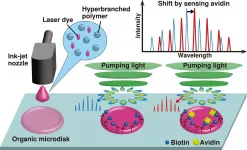
ELSE PRESS RELEASES FROM THIS DATE:
2021-02-03
Coffee rust is a parasitic fungus and a big problem for coffee growers around the world. A study in the birthplace of coffee - Ethiopia - shows that another fungus seems to have the capacity to supress the rust outbreaks in this landscape.
"Coffee leaf rust is a fungal disease that is a problem for coffee growers around the world, especially on Arabica coffee, which accounts for three quarters of global coffee production and has the finest cup quality. There is a need to learn more about natural solutions instead of just applying pesticides," says Kristoffer Hylander, professor at the Department of Ecology, Environment and Plant Sciences (DEEP) at Stockholm ...
2021-02-03
Many nations place drugs into various schedules or categories according to their risk of being abused and their medical value. At times, drugs are rescheduled to a more restrictive category to reduce misuse by constricting supply. A new study examined lessons from past efforts worldwide to schedule and reschedule drugs to identify general patterns and found that rescheduling drugs can lower use as well as the dangers associated with the drug. The findings have implications for policy.
The study, by researchers at Carnegie Mellon University (CMU), is published in the International Journal of Drug Policy.
"Our review suggests that rescheduling drugs can often disrupt trends in prescribing, use, or harms," says Jonathan Caulkins, professor of operations research and public policy at CMU's ...
2021-02-03
In the first longitudinal study to follow Georgia pre-K students through middle school, Stacey Neuharth-Pritchett, associate dean for academic programs and professor in UGA's Mary Frances Early College of Education, found that participating in pre-K programs positively predicted mathematical achievement in students through seventh grade.
"Students who participated in the study were twice as likely to meet the state standards in their mathematics achievement," said Neuharth-Pritchett. "School becomes more challenging as one progresses through the grades, and so if ...
2021-02-03
Russian enterprises have limited opportunities to carry out technological modernisation on their own. Their technological portfolios reveal a high dependence on imported solutions and a limited deployment of their own developments, HSE University researchers discovered.
In recent years, there has been a growing demand for the use of advanced manufacturing technologies (AMT) in Russia. Between 2011 and 2018, the number of AMT used increased by 33%, and in 2018 they amounted to almost 255,000 units in absolute terms. Meanwhile, innovation strategies focused on independent development of novel manufacturing solutions are not widespread in Russia. Fewer than ...
2021-02-03
GROUND-BREAKING research from the University of Huddersfield, announced ahead of World Cancer Day 2021, proves that scalp cooling physically protects hair follicles from chemotherapy drugs. It is the world's first piece of biological evidence that explains how scalp cooling actually works and the mechanism behind its protection of the hair follicle.
The study, entitled 'Cooling-mediated protection from chemotherapy drug-induced cytotoxicity in human keratinocytes by inhibition of cellular drug uptake', has been published in the peer-reviewed journal PLOS ONE .
The data was part of an innovative hair follicle research project carried out by the dedicated Scalp Cooling ...
2021-02-03
Antimicrobial packaging is being developed to extend the shelf life and safety of foods and beverages. However, there is concern about the transfer of potentially harmful materials, such as silver nanoparticles, from these types of containers to consumables. Now, researchers reporting in ACS Applied Materials & Interfaces illustrate that silver embedded in an antimicrobial plastic can leave the material and form nanoparticles in foods and beverages, particularly in sweet and sugary ones.
Some polymers containing nanoparticles or nanocomposites can slow ...
2021-02-03
In the Namib Desert in southwestern Africa, the Kuiseb River, an ephemeral river which is dry most of the year, plays a vital role to the region. It provides most of the vegetation to the area and serves as a home for the local indigenous people, and migration corridor for many animals. The overall vegetation cover increased by 33% between 1984 and 2019, according to a Dartmouth study published in Remote Sensing .
The study leveraged recent drone imagery and past satellite imagery to estimate past vegetation cover in this linear oasis of the Kuiseb River, a fertile area in the middle of one of the driest deserts ...
2021-02-03
Some of the most commonly used drugs for treating hereditary breast and ovarian cancers may not work the way we thought they did, according to new University of Colorado Boulder research.
The paper, published February 2 in the journal Nature Communications, sheds new light on how they do work and could open the door to new next-generation medications that work better, the authors said.
"Despite the success of these drugs which sell in the billions of dollars per year and treat many thousands of patients, there are many unknowns about their potency and efficacy that if better understood ...
2021-02-03
BUFFALO, N.Y. - A popular streaming service boasts a film inventory approaching 4,000 titles. When it's time to pick a movie, are you more likely to quickly make a decision or meticulously sift through the possibilities?
Psychologists refer to those who search minimally for something to arrive at an adequate choice as "satisficers." It's the "maximizers," meantime, who search exhaustively for what might be considered as the perfect option.
Previous studies exploring both strategies after making a choice often present satisficing as a more psychologically ...
2021-02-03
An important bacterial disease that affects citrus trees and causes lesions, citrus canker has been effectively controlled by spraying copper. However standard management techniques involve spraying excessive amounts of copper and water without consideration for the size of the trees.
"This technique resulted in a waste of resources as well as higher costs, detrimental environmental impact, and risk for development of copper resistant strains," explained plant pathologist Franklin Behlau, who recently published an article discussing a more sustainable approach to managing citrus canker.
Behlau and his colleagues showed that it is possible to control citrus canker by spraying ...
LAST 30 PRESS RELEASES:
[Press-News.org] New ink jet approach offers simple way to print microdisk lasers for biosensing
Advance could one day allow on-demand, on-site printing of biosensors

